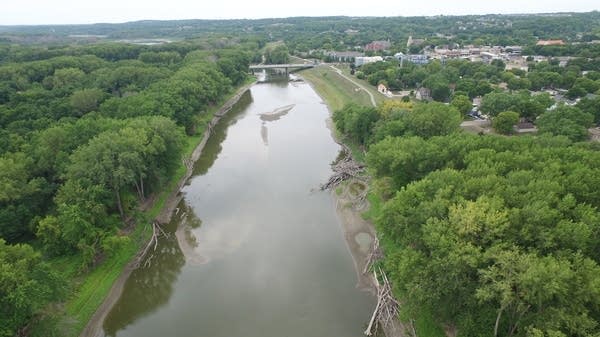Scientists seize chance to study phosphorus in low Minnesota River

Go Deeper.
Create an account or log in to save stories.
Like this?
Thanks for liking this story! We have added it to a list of your favorite stories.
During this summer’s drought, the Minnesota River dropped to near historic low levels, exposing riverbanks and sandbars.
But those low flows also created optimal conditions — last seen in 2012 — for researchers to collect data on phosphorus from wastewater treatment plants, and its effects on the river’s health.
“The silver lining of having a drought condition or low flow is that we're actually able to go conduct this study, and it doesn't happen very often — on the order of every 10 to 15 years,” said Lee Engel, water monitoring supervisor for the Minnesota Pollution Control Agency.
Phosphorus promotes the growth of algae, which eventually decays and strips the water of oxygen needed to support fish, bugs and other aquatic life.
Turn Up Your Support
MPR News helps you turn down the noise and build shared understanding. Turn up your support for this public resource and keep trusted journalism accessible to all.
It comes from runoff from agricultural fields and urban areas, but also from city wastewater treatment plants that discharge treated sewage into the river.

In a typical August, when the river is flowing at 3,000 cubic feet per second, it’s hard to figure out the different sources of phosphorus that could be causing problems in the river, Engel said.
But in August, the river’s flow dipped as low as 540 cubic feet per second, with almost no runoff coming in from the landscape.
“When we effectively remove that overland flow and we're just dealing with what's in the stream, it's easier to quantify the contribution of wastewater treatment facility water coming in,” Engel said. “And it's easier for us to tease out what we think is happening.”
In early August, MPCA staff placed instruments in the river, along a 22-mile stretch from Shakopee to St. Paul.
They measured the amount of dissolved oxygen in the river, which is important to aquatic life.
During a drought, fish, bugs and other aquatic life are already under stress, Engel said. That situation can be even worse if there are high concentrations of phosphorus coming into the river, promoting algae growth that will further rob the water of oxygen, he said.
“It basically makes a tough situation on biology even tougher,” Engel said.
With less water to absorb solar radiation, low rivers tend to be warmer, which also promotes algae growth.
This year’s study is a chance to gauge progress on efforts to limit phosphorus pollution from wastewater treatment plants and through better land management practices, Engel said.
In 2004, the MPCA required dozens of wastewater treatment plants that discharge into the Minnesota River basin to adopt stricter phosphorus limits. A 2012 study found that the limits were helping improve conditions in the river.
"The goal is to reduce phosphorus coming into the river,” Engel said. “The question is, can we tell if we're making a difference at this point?”
He hopes data collected from the study will be available by early November.


